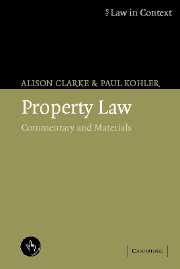Book contents
- Frontmatter
- Contents
- Preface
- Acknowledgments
- Table of cases
- Table of statutes
- Table of statutory instruments
- Table of treaties
- Table of EC legislation
- Part 1 The concept of property
- Part 2 The nature of proprietary interests
- Part 3 The acquisition and disposition of property interests
- 10 Title
- 11 Acquiring title by possession
- 12 Transfer and grant
- 13 Acquiring interests by other methods
- 14 Enforceability and priority of interests
- 15 Registration
- Part 4 Proprietary relationships
- Bibliography
- Index
14 - Enforceability and priority of interests
Published online by Cambridge University Press: 05 June 2012
- Frontmatter
- Contents
- Preface
- Acknowledgments
- Table of cases
- Table of statutes
- Table of statutory instruments
- Table of treaties
- Table of EC legislation
- Part 1 The concept of property
- Part 2 The nature of proprietary interests
- Part 3 The acquisition and disposition of property interests
- 10 Title
- 11 Acquiring title by possession
- 12 Transfer and grant
- 13 Acquiring interests by other methods
- 14 Enforceability and priority of interests
- 15 Registration
- Part 4 Proprietary relationships
- Bibliography
- Index
Summary
Rationale of enforceability and priority rules
Any legal system that allows multiple property interests to subsist in the same thing at the same time must have rules governing their enforceability and priority. Enforceability questions arise when O, the holder of a property interest (for example, the fee simple interest in a plot of land, or a twenty-one-year lease of a flat, or ownership of a painting), grants a subsidiary interest to someone else, S (for example, O grants S a right of way over the plot of land, or sublets the flat to her for five years, or declares he holds the painting on trust for her), but then transfers his own interest to P. In what circumstances will S's interest in the plot of land, the flat and the painting be enforceable against P, so that P holds it subject to S's interest?
Priority questions arise when two or more subsidiary interests are carved out of O's interest, and we need to know which takes priority over the other. The subsidiary interests might all be of the same nature – for example O might first mortgage his fee simple in the plot of land, his lease of his flat and his picture to his Bank B to secure his overdraft of £1 m, but then have a charging order made under the Charging Orders Act 1979 over all three assets to secure a debt of £500,000 he owes to C. If the total value of the three assets is less than £1.5 m, B and C need to know how their interests rank as between themselves.
- Type
- Chapter
- Information
- Property LawCommentary and Materials, pp. 512 - 536Publisher: Cambridge University PressPrint publication year: 2005



